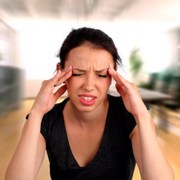 iStockphoto/Thinkstock
iStockphoto/Thinkstock
June is Migraine Awareness month and although 36 million people in the United States suffer with migraine headaches, researchers have still found no cure.
How much do you know about migraine headaches?
1. Migraine headaches are always accompanied by aura, nausea and vomiting. True or False
False. While "with aura" are accompanied by visual disturbances, nausea, vomiting, dizziness, extreme sensitivity to sound, light, touch and smell, "migraines without aura" can occur with severe pain but no other aura-like symptoms.
2. Caffeine can relieve migraines. True or False
True. Caffeine is a common ingredient in many prescription and over-the-counter headache medications. Caffeine additives make pain relievers 40 percent more effective in treating headaches.
Caffeine also helps the body absorb headache drugs more quickly, bringing faster relief. By adding caffeine and, in turn, taking less medication, you can reduce the risk for potential side effects and possible drug addiction.
3. All migraines occur on the one side of the head. True or False
False. The unilateral headaches typically change sides from one attack to the next and 1/3 of the attacks can occur on both sides or the back of the head.
(Warning, a new headache with pain that occurs on the same side of the head should alert the doctor to consider other issues such as a brain tumor.)
4. Migraine affects women than men. True or False
True. Approximately 27 million female sufferers are in the United States, most during peak reproductive years. More severe and more frequent attacks often happen around the monthly cycle as a result of fluctuations in estrogen levels.
5. A migraine and tension headache are the same thing. True or False
False. Although stress can bring on a migraine, the mild to moderate pain from a tension headache is often described as feeling like a tight band around your head. Physical activity typically worsens migraine pain, but the same type of exercise may relieve a tension headache.
6. Botox is considered a treatment for migraines.True or False
True. The National Institute for Health and Clinical Excellence (NICE) has recently given the go-ahead to prescribe Botox injections as a treatment for those who are badly affected by chronic migraines, but it is important to seek out a migraine specialist for this type of treatment.
7. Relaxation techniques often relief migraines without the use of medication.True or False
True. Acupuncture, biofeedback and massage therapy have become effective treatments for some migraine suffers. Massage therapists from The University of Miami found that treatment between migraine attacks, involving deep tissue work around the base of the skull, neck, shoulders, and upper back, helped to relieve tension contributing to the recurrence of migraines.
8. Migraine headaches are frequently undiagnosed and undertreated. True or False
True. Because migraines remain a poorly understood condition, nearly half of all migraine sufferers go undiagnosed and many do not seek medical care for their pain. Only 4 percent of migraine sufferers who seek medical care consult headache and pain specialists.
Further reading and sources:
Fact Sheet. Migraine Research Foundation. Web. 6, June, 2012
http://www.migraineresearchfoundation.org/print-friendly/fact-sheet.html
Botox Gets Nod for Migraines. PubMed Health. Web. 6, June, 2012.
http://www.ncbi.nlm.nih.gov/pubmedhealth/behindtheheadlines/news/2012-05-11-botox-gets-nod-for-migraine
Migraines, Headaches, and Caffeine. WebMd. Web. 6, June, 2012
http://www.webmd.com/migraines-headaches/guide/triggers-caffeine
Keeping in Touch: How Massage Therapy Can Help Your Migraines. Huffington Post Healthy Living. Web. 6, June, 2012
http://www.huffingtonpost.com/olivia-rosewood/keeping-in-touch-how-mass_b_117771.html
Tension Headache. Mayo Clinic. Web. 6, June, 2012
http://www.mayoclinic.com/health/tension-headache/DS00304
Migraine Headache. Medicine.net. p.4. Retrieved June 6, 2012.
http://www.medicinenet.com/migraine_headache/page4.htm
Reviewed June 7, 2012
by Michele Blacksberg RN
Edited by Jody Smith






Add a Comment4 Comments
Thank you for taking time to read. :)
June 8, 2012 - 6:02amThis Comment
You're right, TRobert, thanks for the heads up. It's been removed. :)
June 7, 2012 - 2:56pmThis Comment
You're welcome. Thank you for being so responsive.
June 7, 2012 - 7:47pmThis Comment
You need to review your answer for Number 5. Triptans should NOT be used daily. They are NOT meant to be used as preventives, and the prescribing information for them clearly states so.
Overuse of triptans can cause medication overuse headache (MOH) . In fact, there is a subcategory of MOH in the International Headache Society criteria called triptan overuse headache (8.2.2).
June 7, 2012 - 1:02pmThis Comment